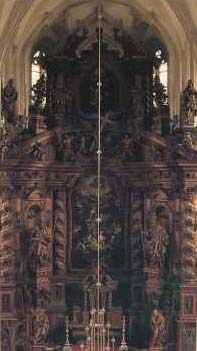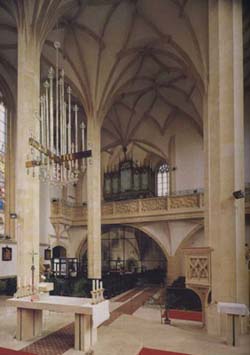The Church Interior

The inside of the church is in the so-called 'hall-Gothic', which means that there is one hall, the vault of which is supported by six slender octagonal columns. Circumferential and relatively thin walls are supported by pillars outside. The space is lightened by seventeen tall windows ended by a gentle rosette. Some of them are liven up by pictures on the glass. The whole lot is roofed over with a late Gothic ribbed net-intersected vault.
The stone pulpit from 1540 decorated with shamrocks and lilies is the pearl of the inside equipment of the temple. Its entry is prettified by two little renaissance angels.
On the railing in the middle of the choir, the emblem of the town of Louny can be noticed. In the Middle Ages the town used to be called "Luna", that is why the Moon - Luna is a part of the emblem.
The tripartite lime baroque altar made between the years 1701-1708 comes from the workshop of sculptors and woodcarvers Jeroným Kohl and František Preiss. Joinery was performed by Marcus Nonnenmacher. Altar pictures were painted by Jan Schummer. At the main altar we see "The Birth of the Lord", and a picture of St Nicolas at the top. The altar is also decorated by statues of St Nicolas, St Barbara, St Wenceslas, and St Leopold. Pillars with festoons and leaf and flower ornaments give the evidence of Corinthian style.

On the epistolary side there is a picture of St John the Baptist and St John the Evangelist at the top. On the evangelical side we can admire pictures of the Assumption of the Virgin and the Trinity.
Oak pews from 1693 are a gift from the town hall. Therefore there are emblems of the town on their sides.
The tin baptismal font (at the right side from the choir view) was made by sculptor Václav Klatovský. At the same side next to the altar of St John the Baptist there is a tombstone of Mister Jan Hruška from Březno. The bronze part of the tombstone was cast in 1568 by Master Brixius from Prague.
Stations of the Cross consist of fourteen carved relieves - bas-relieves. It was made in 1939 by Master František Charvát from Kutná Hora after the fashion of painter Feuerstein's pictures.
The organ was built in 1888 by Prague organ maker Peter from Prague.

